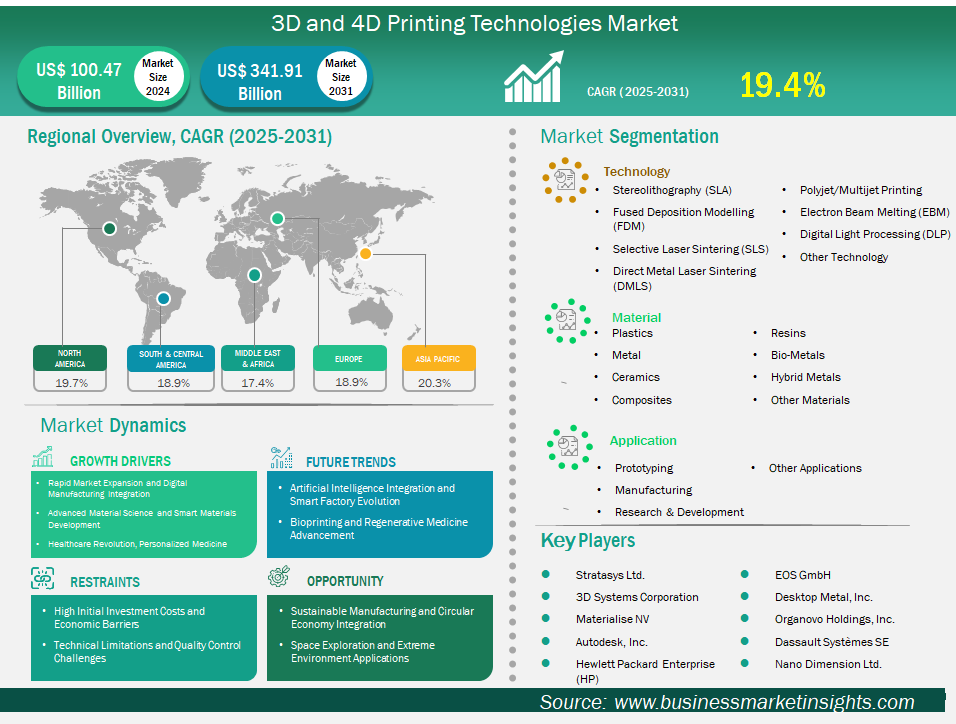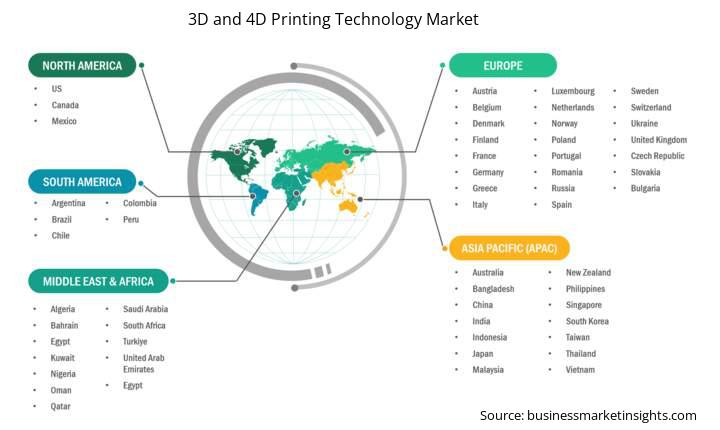3D and 4D Printing Technology Market Outlook (2021-2031)
No. of Pages: 200 | Report Code: BMIPUB00031685 | Category: Electronics and Semiconductor
No. of Pages: 200 | Report Code: BMIPUB00031685 | Category: Electronics and Semiconductor
The 3D and 4D printing technology market size is expected to reach US$ 341,935.81 million by 2031 from US$ 100,479.73 million in 2024. The market is estimated to record a CAGR of 19.4% from 2025 to 2031.
3D printing, also known as additive manufacturing, creates three-dimensional objects by layering material based on a digital model, allowing for complex geometries and customization across various industries. In contrast, 4D printing introduces a time-based transformation capability, using smart materials that respond to environmental stimuli such as heat, light, or moisture, enabling printed objects to change shape, colour, or function autonomously over time. This innovation is made possible by programmable materials like hydrogels and shape-memory polymers, which react predictably to external triggers. This rapid growth is fuelled by rising demand from aerospace, healthcare, automotive, and consumer goods sectors for advanced prototyping, customized products, and smart, adaptive materials. Technological advancements, increased R&D investments, and a shift toward sustainable manufacturing further drive adoption. North America, Europe, and Asia-Pacific are the leading regions, with Asia-Pacific expected to grow fastest due to industrialization and supportive policies.
One key driver of the global 3D and 4D printing technology market is the growing demand for customization and rapid prototyping across multiple industries. Businesses in sectors such as aerospace, healthcare, automotive, and consumer goods increasingly require tailored solutions to meet specific customer needs and to accelerate product development cycles. 3D printing enables the efficient creation of complex, customized parts and prototypes, reducing time-to-market and allowing for design flexibility. The emergence of 4D printing further enhances this capability by introducing smart, adaptive materials that can change shape or function in response to environmental stimuli, opening new possibilities for dynamic, self-assembling products. This trend is supported by advancements in material science and digital manufacturing technologies, which allow companies to innovate faster, minimize waste, and respond more effectively to evolving market demands.

Key segments that contributed to the derivation of the 3d and 4d printing technologies market analysis are technology, material, application, and end user.
Material science advancements are significantly driving both 3D and 4D printing markets through the development of sophisticated materials with enhanced properties. In 3D printing, the expansion from basic polymers to high-performance metals, ceramics, and composite materials has broadened application possibilities across industries. The development of biocompatible materials, conductive inks, and self-healing materials is opening new frontiers in medical applications and electronics. For 4D printing specifically, innovations in shape-memory polymers, hydrogels, and nanomaterials are enabling the creation of structures that can change properties over time in response to environmental stimuli. These smart materials, including shape-memory alloys and programmable polymers, allow objects to self-assemble, adapt, or transform without external power sources. The emergence of multi-material printing capabilities and biocompatible smart materials is expanding the market potential, particularly in aerospace applications where weight reduction and environmental adaptability are crucial.
The growing emphasis on sustainability presents significant opportunities for 3D and 4D printing technologies to contribute to circular economy initiatives. 3D printing enables substantial waste reduction compared to traditional subtractive manufacturing methods, while the ability to recycle materials into new printing filaments supports sustainable production cycles. The technology allows for on-demand production, reducing the need for large inventories and minimizing the risk of overproduction or stockouts. By 2030, eco-friendly materials such as biodegradable plastics and recycled metals will dominate the market, aligning with Dubai's sustainability focus and global environmental goals. 4D printing offers additional sustainability benefits through self-healing materials that can extend product lifecycles and reduce replacement needs. The ability of 4D printed objects to self-transform enables efficient use of scarce resources as they respond to external stimuli, resulting in easier disposal and contributing to environmental preservation. Companies can leverage these sustainability advantages to meet increasingly stringent environmental regulations while reducing material costs and waste management expenses.
By technology type, the 3d and 4d printing technologies market is segmented into Stereolithography (SLA), Fused Deposition Modelling (FDM), Selective Laser Sintering (SLS), Direct Metal Laser Sintering (DMLS), Polyjet/Multijet Printing, Electron Beam Melting (EBM), Digital Light Processing (DLP), and Others. Stereolithography leads the 3D and 4D printing technologies market due to its exceptional precision and accuracy, achieving layer resolutions as fine as 0.025 millimeters compared to FDM's 0.1-0.3 millimeters. SLA produces superior surface finishes with minimal layer lines and delivers dimensional accuracy within 0.2%. The technology's ability to create complex geometries with high-resolution details makes it ideal for healthcare, dental, and precision manufacturing applications. Additionally, SLA's compatibility with smart materials and shape-memory polymers enables advanced 4D printing applications, allowing printed objects to transform in response to environmental stimuli
By material type, the 3d and 4d printing technologies market is segmented into Plastics, Metal, Ceramics, Composites, Resins, Bio-Metals, Hybrid Metals, and Others. Plastics dominate the 3D and 4D printing market due to their exceptional versatility, cost-effectiveness, and ease of processing. Thermoplastics can be repeatedly melted and reshaped, making them ideal for recycling and multiple manufacturing cycles. Their printability enables precise layer-by-layer construction with excellent dimensional accuracy and smooth surface finishes. Plastics offer superior design flexibility for complex geometries while maintaining affordability compared to metals. Smart polymers enable 4D printing applications with shape-memory properties and stimulus-responsive behaviour.
By technology, the 3d and 4d printing technologies market is segmented into low-slice CT scanners, mid-slice CT scanners, high-slice CT scanners and cone beam CT. High-slice CT scanners segment dominated the market in 2024. Covers the widest range of high-volume procedures including abdominal, thyroid, and vascular scans. Used in nearly all patient evaluations, driving consistent and dominant usage.
By application, the 3d and 4d printing technologies market is segmented into Prototyping, Manufacturing, Research & Development, and Others. The oncology segment dominated the market in 2024. The manufacturing application dominates 3D and 4D printing technologies markets as the largest application. Manufacturing applications include prototyping, tooling, and end-use parts production. The sector leverages additive manufacturing for complex geometries, customization, and reduced lead times.
By end user, the market is segmented into Aerospace & Defense, Automotive, Healthcare, Consumer Goods, Construction, Education & Research, and Electronics. The automotive industry is the largest end-user of 3D and 4D printing technologies, utilizing them for rapid prototyping, customized parts, and lightweight components. Manufacturers like Ford and BMW leverage these technologies to enhance design flexibility, reduce production costs, and develop adaptive materials, significantly driving market demand.
3D and 4D Printing Technology Market Report Highlights
Report Attribute
Details
Market size in 2024
US$ 100,479.73 Million
Market Size by 2031
US$ 341,935.81 Million
Global CAGR (2025 - 2031) 19.4%
Historical Data
2021-2023
Forecast period
2025-2031
Segments Covered
By Technology
By Material
By Application
By End Use Industry
Regions and Countries Covered
North America
Europe
Asia-Pacific
South and Central America
Middle East and Africa
Market leaders and key company profiles
The "3d and 4d printing technologies Market Size and Forecast (2021–2031)" report provides a detailed analysis of the market covering below areas:

The geographical scope of the 3d and 4d printing technologies market report is divided into five regions: North America, Asia Pacific, Europe, Middle East & Africa, and South & Central America. The 3d and 4d printing technologies market in Asia Pacific is expected to grow significantly during the forecast period.
North America currently dominates the global 3D and 4D printing technologies market, holding the largest market share among all regions. North America accounted for more than 33% of the global 3D and 4D printing technologies market revenue in 2024. This regional leadership can be attributed to several key factors. The extensive adoption of additive manufacturing technologies across North American industries, particularly in the United States and Canada, has positioned the region as an early adopter of these advanced manufacturing processes. The region benefits from substantial government investments, with the U.S. Department of Defense including 3D printing as an important capability in its budget, while tech giants like Microsoft, HP, and Autodesk have launched specialized products for additive manufacturing
The 3d and 4d printing technologies market is evaluated by gathering qualitative and quantitative data post primary and secondary research, which includes important corporate publications, association data, and databases. A few of the key developments in the 3d and 4d printing technologies market are:
The 3D and 4D Printing Technology Market is valued at US$ 100,479.73 Million in 2024, it is projected to reach US$ 341,935.81 Million by 2031.
As per our report 3D and 4D Printing Technology Market, the market size is valued at US$ 100,479.73 Million in 2024, projecting it to reach US$ 341,935.81 Million by 2031. This translates to a CAGR of approximately 19.4% during the forecast period.
The 3D and 4D Printing Technology Market report typically cover these key segments-
The historic period, base year, and forecast period can vary slightly depending on the specific market research report. However, for the 3D and 4D Printing Technology Market report:
The 3D and 4D Printing Technology Market is populated by several key players, each contributing to its growth and innovation. Some of the major players include:
The 3D and 4D Printing Technology Market report is valuable for diverse stakeholders, including:
Essentially, anyone involved in or considering involvement in the 3D and 4D Printing Technology Market value chain can benefit from the information contained in a comprehensive market report.